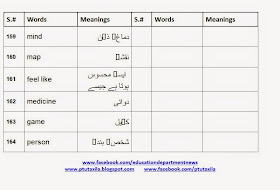Unit-3 English-5
Notes on
Cold Cure
READING COMPREHENSION
A- Answer
the following questions.
1. She caught cold
2. The
symptoms of cold are sneezing, sore throat, stuffy nose and fever.
3. You
may catch cold if you touch something that has cold virus on it.
4. We
should take hot drinks like chicken soup; blow our nose to get rid of mucus,
take rest and gargle to soothe our sore throat.
5. We can avoid cold by doing the following
things:-
Keep
our hands, toys and other things clean,
Use
a tissue or a handkerchief at the time of coughing or sneezing,
Avoid
using drinking glasses, cloths, towels etc. belonging to some having cold or
fever,
B- Put
tick or cross
Grammar
Use
of has/have
a. Match nouns and pronouns with have or has.
Ali
has, Nidda and Fizza have, boy has, children have, cat has, books have, he has,
they have, it has, we have, she has, you have, I have.
b. Choose has or have.
1-
has, 2- have, 3- has, 4- have, 5- has
c. Fill in the blanks with has or have.
1-
has, 2- have, 3- has, 4- have, 5- has
d. Complete these sentences with appropriate
pronouns.
1- my,
mine
2- her, hers
3- their, theirs
4- your, yours
5- our, ours
PHONICS
Hard
and soft /c/ sounds.
cab,
car, cat, cow, cookie, cold, cube, cup. hard
cent,
nice, face, city, pencil, dance, spicy, mice: soft
WRITING SKILLS
A- Answer
the following questions in complete sentences.
Use
either “have” or “has” in your answer.
1- I have two feet.
2- My room has two beds.
3- My bag has three pockets.
4- My hands have ten fingers.
5- Northern
Areas have very cold weather in winter but very pleasant one in summer.
B- Pair
works.
1- I have two pencils but he has one eraser.
2- I have three rulers but she has two
sharpeners.
3- I have one pair of shoes but she has two
pairs of shoes.
4- I have two suits but she has one suit.
5- I have one bag but she has two bags.
6- I have a bicycle but he has a car.
7- I have a small house but he has a big
house.
8- I have two brothers but she has three
brothers.
9- I have one son but she has two sons.
When I Caught Cold
I caught cold last
month. I also had fever and sore throat with it. My nose was stuffy and I could
not breathe. I was feeling very tired. I visited a doctor for check-up and
treatment. He did not give me any medicine. He prescribed me to take chicken
soup and rest. He also advised me to gargle to soothe my sore throat. I
followed the doctor’s advice and started feeling better. It took me five days
to recover from this illness.
Oral Communication
1- Does Raza have a dog?
Yes,
he has.
2- Does Sana have a cat?
Yes,
she has.
3- Does Karim have a flower?
Yes,
he has.
4- Does Asif have any toys?
Yes,
he has some.
Use of has and have
“has” is
used with he, she, it and singular noun (third person). For example:-
1. He has two books. (اُس کے پاس دو کتابیں ہیں)
2. She has three brothers.
3. It has four legs.
4.
Yasir has a bicycle.
5. Fatima has a doll.
We always use third form of the verb
after “has”. For example:-
1. He has drunk a glass of water. (اُس نے پانی کا
ایک گلاس پی لیا ہے)
2. She has eaten an apple.
3. It has broken its right leg.
4. Yasir has beaten his brother.
5. Fatima has given a mango to her
father.
We use
“has to” with the first form of the verb to indicate obligation
(لازمی، مجبوری). For example:-
(لازمی، مجبوری). For example:-
1. He has to go to school on foot. (اُسے سکول پیدل جانا پڑتا ہے)
2. She has to cook food, herself. (اُسے کھانا خود پکانا پڑتا ہے)
3. Yasir has to help his father in the
fields. (یاسر کو کھیتوں میں اپنے ابو کی مدد کرنی پڑتی ہے)
"have” is used with I, we,
you, they, and plural nouns. For example:-
1. I have a pen.(میرے پاس ایک قلم ہے)
2. We have five teachers in our school.
3. You have three brothers.
4. They have a lot of money.
5. Yasir and Amina have two pencils each.
We always
use third form of the verb after “have”. For example:-
1. I have written a letter. (میں نے ایک خط لکھ دیا ہے)
2. We have done our homework.
3. You have gone home.
4. They have reached the school.
5. Fatima and Yasir have answered all the
questions.
We use
“have to” with the first form of the verb to indicate obligation (لازمی، مجبوری). For example:-
1. I have to clean my office, myself. (مجھے اپنا دفتر خود صاف کرنا پڑتا
ہے)
2. We have to be there by 5 o’clock. (ہمیں پانچ بجے تک وہاں پر ہونا ہے)
Unit-3 English-5
Notes on
Cold Cure

















Great effort.
ReplyDelete